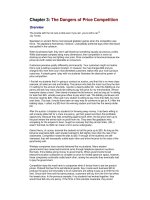Thes danders of price competition
Bạn đang xem bản rút gọn của tài liệu. Xem và tải ngay bản đầy đủ của tài liệu tại đây (72.07 KB, 8 trang )
Chapter 3: The Dangers of Price Competition
Overview
The trouble with the rat race is that even if you win, you’re still a rat.
[1]
Lily Tomlin
Spectators in ancient Rome most enjoyed gladiator games when the competition was
fierce. The gladiators themselves, however, undoubtedly preferred days when little blood
was spilled in the coliseum.
When businesses fight, they don’t spill blood but something equally as precious, profits.
While businesses compete along many dimensions, their competition is never as
draining as when they are fighting over price. Price competition is ferocious because low
prices are both visible and desirable to consumers.
Customers perceive quality differently and inexactly. Your customers might not realize
that a rival is selling a superior product. If, however, the rival charges $90 and you
charge $100, then even your most dimwitted customers realize that your rival’s product
costs less. A simple game I play with my students illustrates the destructive power of
price competition.
I first tell my students that I’m going to conduct an auction, and that this is no mere class
exercise; all sales are real and binding. The person who bids the most must buy the item
I’m selling for the amount she bids. I auction a twenty-dollar bill. I start the bidding at one
penny and ask how many would be willing to pay this price for my merchandise. Almost
everyone raises a hand. I then slowly increase the bid amount, and as long as I’m asking
for less than $20, virtually everyone offers to pay what I ask. The bidding continues until
the price reaches $20. I then ask if any student is willing to pay more than $20, but none
ever does. (Too bad, it would have been an easy way for someone to get an A.) After the
bidding stops, I collect my $20 from the winning student and hand her the twenty-dollar
bill.
After the auction I chastise my students for throwing away money. I had been willing to
sell a twenty-dollar bill for a mere one penny, yet their greed cost them this profitable
opportunity. Because they kept competing against each other, the bid price went up to
the point where the winner took no profit from me. They were like gladiators who,
competing for the emperor’s favor, fought so viciously that they all lost limbs. (OK, it
wasn’t that bad, but $20 can mean a lot to some undergrads.)
Game theory, of course, doomed the students to bid the price up to $20. As long as the
bid price was below $20, each student wanted to bid slightly more than the rest of her
classmates. Competition raised the bids to $20. If enough of the students are self-
interested, they will necessarily outbid each other and drive the price to the value of the
good being sold.
Wireless companies have recently behaved like my students. Many western
governments have raised astronomical sums through telephone spectrum auctions.
Normally, firms dislike giving money to governments. When governments forced
telecommunication companies to compete on price for limited spectrum space, however,
these companies continually outbid each other, raising the amounts they eventually had
to pay the government.
Competition does the most harm to companies when it forces them to set low product
prices. Pretend that two firms sell identical goods. Say it costs each business $30 to
produce the good, but fortunately a lot of customers are willing to pay up to $100 for the
item. Since both firms sell the same product, customers will buy from the firm that offers
the lowest price. In the previous example, if my students had worked together, they
would have bid only one penny. If the firms in this example cooperate, they would
obviously each charge $100 and split the customers. What happens, however, if the
firms compete on price? If the other firm is charging $100, your firm could charge $100
and get about one-half of the customers, or charge a little less and get nearly all of them.
Clearly, it would be beneficial to slightly undercut the other firm’s price if it drastically
increases your firm’s sales. Alas, this same game theoretic logic applies to your
competitor.
If both firms continually try to undercut each other, then prices will be driven down to cost.
(Once your rival’s price equals your cost, you won’t lower prices because you would
rather lose all of your customers than sell each good at a loss.) How can firms prevent
destructive price competition from draining all of the profits? If antitrust laws didn’t exist,
the easiest way would be for the firms to make an explicit agreement to charge the same
price. Alas, under antitrust laws such an agreement could land you in prison.
[1]
Boone (1999), 114.
Stopping Price Wars with Credible Threats
During much of the Cold War, the Soviet Empire had both the desire and the ability to
destroy the United States, but fear of retaliation kept the peace. The evil empire believed
that attacking the U.S. with nuclear weaponry would cause America to respond in kind. A
similar type of retaliation can keep firms in your market from lowering prices.
While credibly threatening to use atomic weapons against a price-cutting rival would be
an effective means to limit price competition, acquiring the necessary fissionable
materials could be challenging. An easier method is to threaten to match any price cut. If
your rival considers cutting prices to steal your customers, then his justification for a
price cut would be obliterated if he believes that you would meet any price challenge.
For retaliation to be effective it must be both swift and assured. If your rival suspects that
you might not respond to a price cut, he might lower his price to see how you act.
Furthermore, if he believes that it would take you a few months to respond, he might
lower prices to steal some of your customers. In the time it takes you to act he could get
a short-term boost in sales that might more than make up for starting a minor price war.
Threats of retaliation won't always be enough to suppress price competition, though.
When I auctioned off the twenty-dollar bill, why couldn't my students come to an
agreement not to bid against each other? One of the most challenging endeavors in life
is getting a large group of friends to agree on which movie they should rent and then
collectively watch. This challenge becomes an impossibility when everyone in the group
has veto rights. The reason that my students could not come to an agreement to limit
their bidding was because there were too many of them. After all, it would have taken
just one student to break an agreement. If, for example, all but one had agreed to bid
only one penny and split the profits among themselves then the student left out of the
agreement could bid two cents and make herself a $19.98 profit.
When there are many firms selling the same product it can be nearly impossible for them
to limit price competition. If the prevailing price is above the cost of production, each firm
will have an incentive to slightly undercut its rivals to gain much of the market.
Unfortunately, when everyone does this, prices are driven down to cost, and profits
disappear. In a market with only two firms, each may well believe that if it cuts its price
the competition will do likewise. When a market consists of 50 firms, however, then one
single small firm is unlikely to believe that if it lowers prices then everyone else will
immediately follow. As a result, all the firms will believe that they can get away with
reducing prices without suffering massive retaliation. If all the firms believe this, of course,
then all the firms will lower their prices until all the profits have dissipated. Game theory
thus shows that firms should avoid entering markets where (1) there are a large number
of competing firms and (2) they sell near-identical products. Internet retailing is an
industry where long-term high profits probably can't ever be maintained because these
two conditions are so readily met.
Internet Price Competition
Amazon.com was one of the brightest stars of the tech boom, yet its stock market
success baffled many economists. The Internet multiplies competition, and nearly
anyone can sell books on-line, so Amazon was destined to compete for consumers
based on price alone. While a firm fighting with prices can survive, it shouldn’t prosper.
Imagine two neighboring bookstores in a mall. If a customer found a book in one store
that he liked, it would be easy for him to check whether it was being sold for a lower price
in the other store. If one of these stores had consistently higher prices than the other,
therefore, it would generate little business. Each store would face enormous pressure to
charge lower prices than its neighbor. Now imagine instead that these two bookstores
are in opposite sides of a large mall. It would be much more challenging for customers to
compare prices. A store now could afford to maintain higher prices because its
customers (1) might not realize its prices were higher and (2) might not be willing to walk
to the other store just to save a few cents. The closer the stores, the more likely the
stores are to compete on price because price will have a greater influence on sales.
On the Internet all stores are next to each other. It’s easy to compare prices at different
Internet retailers. This is especially true if you use intelligent searching agents to seek
out low-cost providers. Consequently, web consumers are especially price-sensitive and
Internet retailers have large incentives to undercut rivals because the firm that charges
the lowest price is likely to get most of the business. Of course, if everyone tries to
charge the lowest price, then prices plunge and profits disappear.
Not only do Internet retailers compete mostly on price, but they also face more
competition than their brick-and-mortar cousins do. If there were, say, 10,000 brick-and-
mortar widget retailers spread across the United States, but only 20 on-line sellers of
widgets, then Internet retailers might actually face more competition. Two stores in the
real world compete only if a customer is willing to shop at either of them. Consequently,
in the real world two bookstores should consider themselves rivals only if they are within,
say, 15 miles of each other. Any connected person can visit any virtual retail store,
regardless of where the store is really located. The actual number of competitors an
Internet retailer faces will thus usually be much higher than the number faced by real-
world stores. Since more rivals means more price competition, Internet retailers will
never achieve sustained high profitability unless, perhaps, they use complex pricing.
Using Complication to Reduce Price Competition
[2]
You’re offered a choice between two long-distance services. One plan charges you ten
cents a minute and the other nine. Obviously, you go with the cheaper plan. Long-
distance providers, however, rarely provide such a stark choice. They offer you
complicated pricing plans that make it difficult to compare long-distance packages.
[3]
Complications reduce the damage of price competition. When firms compete directly on
price, it’s easy for customers to compare. Consequently, there is a massive benefit for
every firm to undercut its rivals. When everyone uses complicated pricing schemes,
however, the benefits to undercutting your rival diminish since customers will be
challenged to find the low-cost provider.
Airlines achieve complicated pricing through frequent-flyer programs.
[4]
Frequent-flyer
miles effectively change the price of airline tickets and make it difficult to determine
which airline offers the lowest price and consequently reduce the benefit to firms of
undercutting their rivals.
[2]
See also Brandenburger and Nalebuff (1996), 222–228.
[3]
Ibid., 225.
[4]
Ibid., 134–138.









